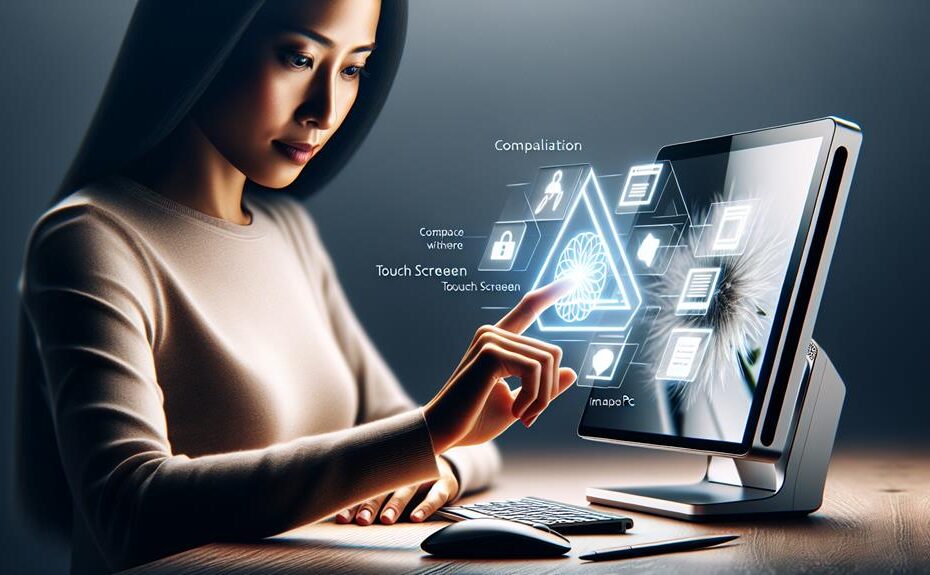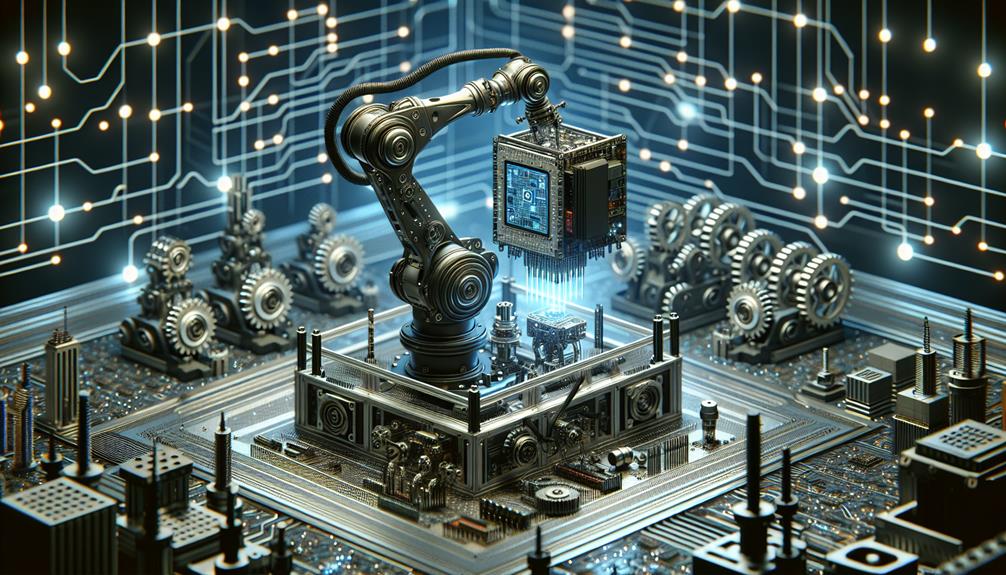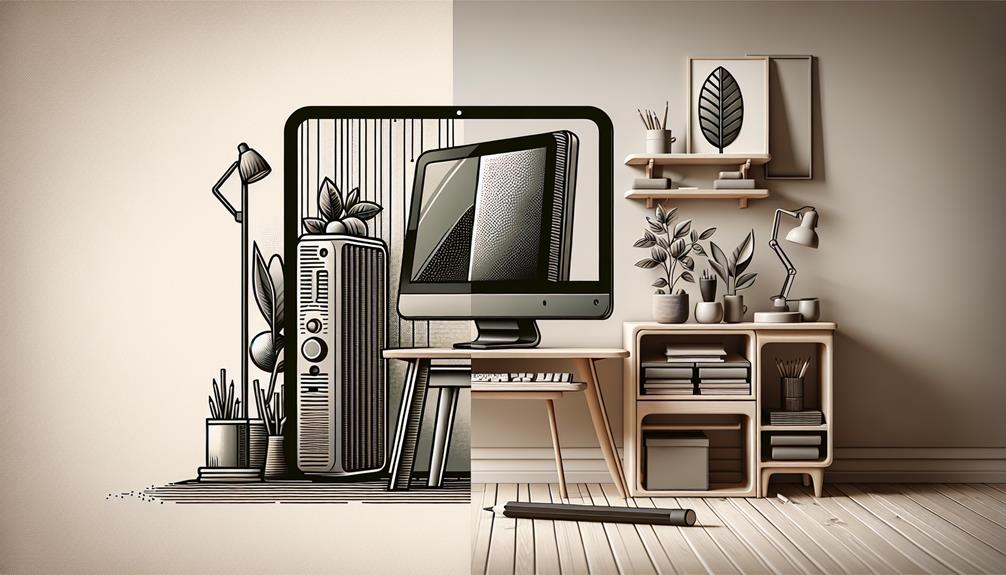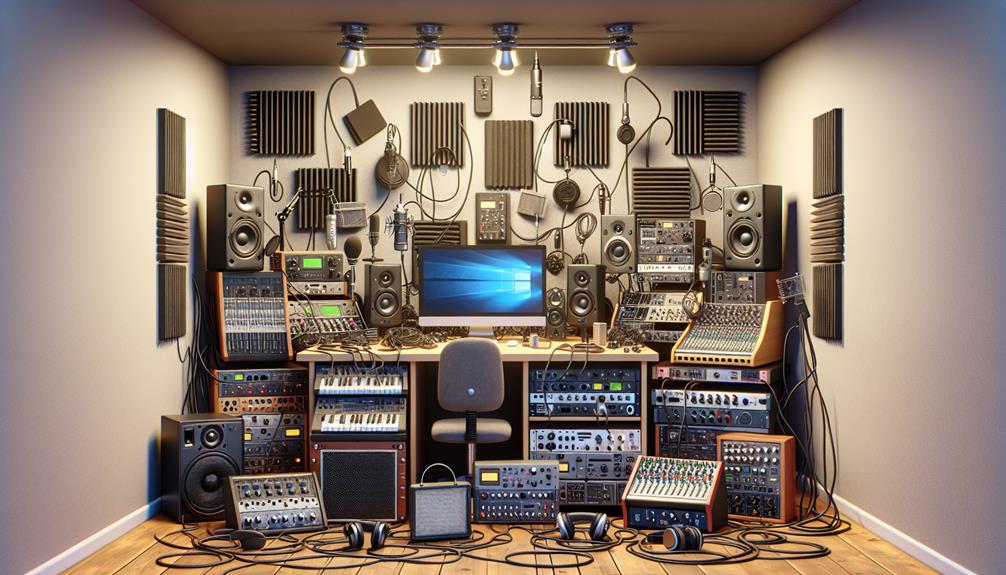Yes, Mini PCs support touch screen monitors. This allows for improved interaction and seamless integration for better user experiences and productivity. Embrace the advantages of touch screen monitors with your Mini PC setup for an ideal computing experience.
Key Takeaways
- Mini PCs can support touch screen monitors with the right hardware connections.
- Touch screen calibration is essential for accurate touch input recognition.
- Mini PCs benefit from touch screen monitors for enhanced user experience.
- Various connection options like USB, HDMI, DisplayPort enable seamless integration.
- Touch screen gestures and controls can boost productivity and interaction on mini PCs.
Understanding Mini PC Capabilities
To fully comprehend the capabilities of mini PCs, it is essential to understand their compact design and powerful performance. Mini PCs, while offering great portability and space-saving benefits, do come with certain limitations. Due to their small size, mini PCs may have limited upgrade options compared to larger desktop computers. Additionally, their processing power and graphics capabilities may not match those of full-sized PCs, making them more suitable for everyday tasks rather than heavy-duty computing.
However, with the advancements in touch screen technology, mini PCs are now being equipped to support touch screen monitors. These monitors enable users to interact with their computers in a more intuitive and efficient manner, enhancing the overall user experience. Touch screen technology has evolved to be more responsive and accurate, allowing for precise input and control. This integration of touch screen capabilities into mini PCs expands their functionality and usability, making them even more versatile tools for various computing needs.
Benefits of Touch Screen Monitors
Touch screen monitors offer a user-friendly interface that enhances interaction with computers through intuitive touch controls. The advantages of touch screens lie in their usability, providing a more direct and tactile way to interact with content on the screen. With touch screens, you can easily navigate through menus, zoom in on images, or scroll through web pages by simply tapping or swiping on the display.
The interactive display functionality of touch screen monitors adds a level of convenience to computing tasks. This feature is particularly useful for tasks that benefit from direct manipulation, such as drawing, designing, or presenting. Touch screens also eliminate the need for a separate input device like a mouse or keyboard, streamlining the user experience and saving desk space.
Factors Affecting Compatibility

Factors impacting compatibility between mini PCs and touch screen monitors can include hardware requirements, compatibility issues, operating system requirements, and driver support. When contemplating hardware specifications, it is vital to confirm that the mini PC has the necessary ports to connect to the touch screen monitor, such as HDMI or DisplayPort. Additionally, verifying that the mini PC meets the screen resolution requirements of the touch screen monitor is essential for best display quality.
Compatibility issues may arise if the mini PC's operating system is not supported by the touch screen monitor or if the drivers are not compatible. It is advisable to check for driver updates and ensure they are properly installed to enable correct communication between the mini PC and the touch screen monitor. Furthermore, the calibration process is another aspect to take into account for ensuring accurate touch input recognition on the monitor.
Mini PC Touch Screen Support
When ensuring compatibility between mini PCs and touch screen monitors, it is essential to take into account the level of touch screen support offered by the mini PC. Touch screen support includes features like touch screen calibration for accurate input recognition and touch screen gestures for enhanced interaction. Mini PCs vary in their touch screen support capabilities, impacting the overall user experience and productivity.
The level of touch screen support can influence mini PC performance, especially when running applications that heavily rely on touch input. Higher touch screen support often means smoother operation and better responsiveness. Additionally, advanced touch screen gestures enable efficient navigation and task management, enhancing the mini PC multitasking capabilities.
Before purchasing a mini PC for use with a touch screen monitor, it is advisable to review the touch screen support specifications to ensure seamless integration and optimal functionality. By considering touch screen calibration, gestures, and multitasking abilities, you can select a mini PC that meets your touch screen computing needs effectively.
Connection Options for Touch Screens
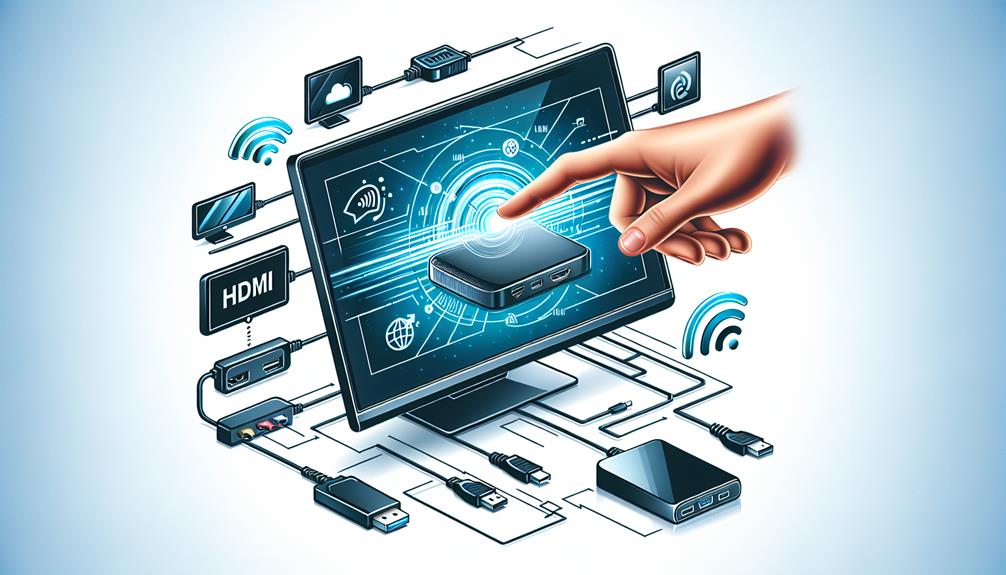
For ideal connectivity with touch screens, mini PCs offer various connection options to guarantee seamless integration. When setting up a touch screen monitor with a mini PC, it is important to take into account touch screen compatibility and connection protocols. Most touch screens connect via USB, HDMI, DisplayPort, or VGA. USB connections are common for touch screen monitors, enabling both touch screen data transfer and power supply through a single cable. HDMI and DisplayPort connections are preferred for high-resolution displays, ensuring peak touch screen calibration and responsiveness. VGA connections are also suitable for older touch screens that lack digital interfaces. To configure touch screen settings on a mini PC, access the display settings in the operating system. Here, you can adjust resolution, orientation, and touch screen sensitivity. By selecting the appropriate connection type and fine-tuning display settings, you can guarantee a smooth touch screen experience with your mini PC.
Software Integration Considerations
Considering the operating system of your mini PC and the software applications you intend to use, integrating touch screen functionality involves configuring settings for best performance and usability. Before enabling touch screen support, make sure that your system meets the necessary hardware compatibility and system requirements. Check if your mini PC's operating system supports touch screen input and if there are specific drivers needed for the touch screen monitor.
To integrate touch screen functionality seamlessly, verify that your software applications are optimized for touch input. Some applications may require specific settings or configurations to fully utilize touch screen capabilities. Additionally, confirm that the touch screen monitor is correctly calibrated to accurately register touch input.
When integrating touch screen functionality, consider the responsiveness and accuracy of the touch input to enhance user experience. Regularly check for software updates and driver compatibility to maintain peak performance. By carefully addressing system requirements and hardware compatibility, you can effectively integrate touch screen functionality into your mini PC setup.
Enhancing User Experience

To enhance user experience with touch screen functionality, ensure precise calibration for accurate touch input registration. Proper calibration guarantees that the touch screen accurately responds to your touch, improving user interaction with the device. Additionally, optimizing screen sensitivity is vital for a seamless user experience. Adjusting the sensitivity settings allows for a more personalized touch experience, catering to individual preferences and usage scenarios. By fine-tuning the screen sensitivity, you can enhance the overall usability of the touch screen monitor, making interactions smoother and more intuitive.
User experience is greatly improved when touch screen monitors are responsive to touch gestures and commands. Ensuring that the touch screen is calibrated correctly and sensitivity levels are appropriately set contributes to a more efficient and enjoyable user interaction. By prioritizing these aspects, you can maximize the usability of the touch screen monitor, providing users with a more intuitive and satisfying experience.
Touch Screen Monitor Setup
Set up your touch screen monitor by following these straightforward steps. Begin by connecting the monitor to your mini PC using the appropriate cables. Make sure the connections are secure to avoid any display issues. Once connected, power on both the monitor and the mini PC. Your operating system should automatically detect the touch screen monitor. If not, you may need to adjust the display settings in your system preferences to enable touch functionality.
To optimize your touch screen experience, you can customize the settings to suit your preferences. This may include adjusting the touch sensitivity, calibrating the touch input, or enabling gestures for easier navigation. Refer to the monitor's user manual for detailed instructions on setting preferences.
If you encounter any issues during the setup process, try troubleshooting techniques such as restarting the devices, checking for driver updates, or ensuring compatibility between the mini PC and the touch screen monitor. By following these steps, you can successfully set up your touch screen monitor for use with your mini PC.
Troubleshooting Touch Screen Issues

When troubleshooting touch screen issues on your setup, start by checking the cable connections and making sure they are secure. Loose connections can result in problems with touch functionality. If the connections are okay, the next step is to perform calibration troubleshooting. Calibration guarantees that the touch screen accurately registers your inputs. Access the calibration settings through your device's control panel or settings menu. Follow the on-screen instructions to recalibrate the touch screen.
If calibration doesn't resolve the issue, you may be experiencing gesture recognition problems. This can happen if the touch screen is not interpreting your gestures correctly. To tackle this, check for any software updates for both the touch screen monitor and your mini PC. Updates often include enhancements to gesture recognition algorithms. Additionally, ensure there are no physical obstructions on the touch screen surface that could be affecting gesture recognition.
Future Trends in Mini PC Technology
Exploring the evolving landscape of mini PC technology reveals exciting advancements on the horizon. When it comes to portable computing, mini PCs are set to become even more compact and powerful. Future trends in mini PC technology point towards increased processing capabilities in smaller form factors, enabling users to carry powerful computing devices in their pockets.
Display innovation is another key aspect of future mini PC trends. Manufacturers are working on integrating cutting-edge display technologies into mini PCs, such as foldable screens and enhanced resolutions, to provide users with an immersive viewing experience on the go. These advancements in display technology will not only enhance the visual quality of mini PCs but also contribute to improved productivity and entertainment options for users.
Disclosure: As an Amazon Associate, I earn from qualifying purchases.
